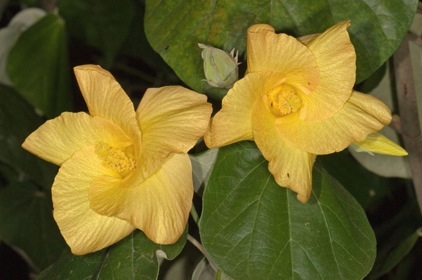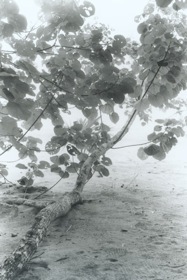Hibiscus pernambucensis: Walking Lunch

Amapola, Hibiscus pernambucensis
The Amapola is on the go, but unlike the “walking” mangrove, the Amapola crawls.
There is something of a debate as to where this tree is native to, but most agree South American up to the Caribbean.* Then the issue becomes what is the definition of “native.” It grows naturally in south Florida but when it got there is a bit of a snit. It is not included in some books about native Florida flowers. We don’t care, really. All we need to know is that it is edible. It closely resembles the Mahoe and Milo (see separate entries) but its flowers lack a dark throat. It does, however, like those other two have yellow flowers that darken over the course of the day, in this case to orange. That and heart-shaped leaves tell you you have the Amapola. *Note that some think it is a native of Asia but how it got here is up for debate.
This is a very tropical, short tree, usually reaching 15 feet in height and growing in colonies. It grows well on well drained, organic soils, but tolerate salty and sandy ones. In south Florida it is seen “crawling” across low dunes. The tree can’t grow in the forest nor too close to the high tide mark. So the tree grows close to the high water mark then falls over. Where the trunk and branches touch the soil it sends out roots and grows along. It is often found in tangled thickets
The flowers make a colorful and tasty salad ingredient and can be cooked like a vegetable. The young leaves, bark, and roots have been cooked and eaten as famine food. Bees like the flowers as do humming birds.
Amapola’s wood is white, light, straight-grained and easy to work. The fibrous inner bark has been used to make ropes, cords, fish nets, floats, cloth, and mats. The bark is used for emergency ties, lashings even fishing line. The wood when dry burns readily. The tree is also planted as an ornamental, a living feance, and to stabilize stream banks and beaches.
The botanical name, Hibiscus pernambucensis, means ”sticky from Pernambuco” read Brazil. Hibsicus is from the Greek word Iviskos (ee-VIS-oks) meaning sticky and where we get the words viscus and viscosity in in English. Hibiscus pernambucensis is said hye-BIS-kiss per-nam-boo-KEN-sis.

Amapola, Hibiscus pernambucensis
Green Deane’s
“Itemized” Plant Profile
IDENTIFICATION:
Bark of the limbs and trunks are gray, smooth, furrowed and scaly when old, leaves are nearly round (four to six inches in diameter) except for a deeply heart-shaped base and a pointed tip. Stems are long (2.5 to 3.5 inches). Flowers large and yellow, changing to orange or red as they age. Hairy, cone-shaped seed capsules develops, when dry it splits along five lines to release seeds.
TIME OF YEAR:
Year round
ENVIRONMENT:
Usually grows just inland of mangroves around brackish lakes and along rivers in the lower reaches of their floodplains, also beachfronts, hammocks, sand dunes and landscaping, grows near brackish lakes, but less tolerant of saline conditions than the mangroves.
METHOD OF PREPARATION:
Flowers raw or cooked, leaves, bark and roots cooked as a famine food.

